Inside The New York Botanical Garden
Archive: January 2010
Posted in Shop/Book Reviews on January 13 2010, by Plant Talk
Check Out These New Titles on Plants and Gardening
 John Suskewich is Book Manager for Shop in the Garden.
John Suskewich is Book Manager for Shop in the Garden.
Will these 10 books stop me from ordering seeds I probably won’t get around to sowing until 2018? Will they prevent me from having a six-foot-tall Panicum come up in front of an eight-inch-tall Catananche? Will they convince me not to try growing Rhododendron yakushimanum for the third time in 10 years in my yard with heavy clay soil and a high water table? Probably not; but here are 10 new books—on plants and gardens and nature and why it all matters—that were recently published or are coming out later this year and that I’ll be reading anyway, no matter what benefit I may or may not get from them!
 A Landscape Manifesto,
A Landscape Manifesto,
by Diana Balmori
Innovative and influential landscape architect Diana Balmori writes on the theory, practice, and future of her profession.
Ken Smith Landscape Architect,
by Ken Smith
This imaginative practitioner, who has changed our idea of what landscape architecture can be, looks at his most important projects.
Garden Guide: New York City,
by Nancy Berner and Susan Lowry
From Gotham’s horticultural Baedeker comes a new edition—it’s always amazing to see how many gardens you can visit here in NYC!
The Japanese Tea Garden, by Marc Peter Keane
No American interprets Japanese garden history and practice better than our colleague Marc Peter Keane.
Read More
Posted in Wildlife on January 12 2010, by Plant Talk
Two Species Normally Found in Spring Spotted on Bird Count
 Carol Capobianco is Editorial Content Manager at The New York Botanical Garden.
Carol Capobianco is Editorial Content Manager at The New York Botanical Garden.
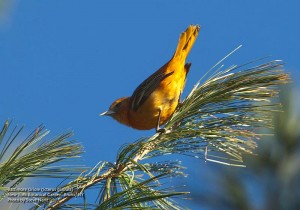 Local birder Rob Jett reports on his Web site The City Birder that two pine warblers and four Baltimore Orioles—bird species that at this time of year are usually much farther south (as in Florida and south of the border)—were recorded on December 27 at the Botanical Garden during the National Audubon Society’s annual Christmas Bird Count.
Local birder Rob Jett reports on his Web site The City Birder that two pine warblers and four Baltimore Orioles—bird species that at this time of year are usually much farther south (as in Florida and south of the border)—were recorded on December 27 at the Botanical Garden during the National Audubon Society’s annual Christmas Bird Count.
The Garden falls within the Bronx-Westchester count area, which this year marked its 86th season. (Roger Tory Peterson was one of the more famous participants.) This is the seventh time in the past 11 years that orioles (see photo at right, by Steve Nanz) were found in the count area, but four is a record high.
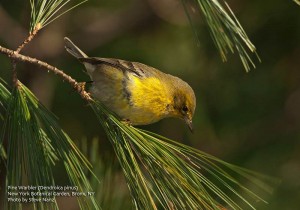 Debbie Becker, who leads the Garden’s weekly bird walks, has seen pine warblers (photo at left, by Steve Nanz) here since early December. And, she says that seeing orioles in December—often near the crabapple trees or the Rock Garden—has become more common. She has conducted her own “unofficial” bird count at the Garden in December for about 20 years. She thinks the sightings of birds such as orioles and warblers in winter may be the result of climate change, and some birds that usually migrate instead find a secure home with plenty of sustenance at the Garden.
Debbie Becker, who leads the Garden’s weekly bird walks, has seen pine warblers (photo at left, by Steve Nanz) here since early December. And, she says that seeing orioles in December—often near the crabapple trees or the Rock Garden—has become more common. She has conducted her own “unofficial” bird count at the Garden in December for about 20 years. She thinks the sightings of birds such as orioles and warblers in winter may be the result of climate change, and some birds that usually migrate instead find a secure home with plenty of sustenance at the Garden.
Read More
Posted in Gardening Tips on January 11 2010, by Sonia Uyterhoeven
 |
Sonia Uyterhoeven is Gardener for Public Education. |
During summer you will often find around the Botanical Garden weeping figs (Ficus benjamina) growing in decorative containers, as they look reliably good all season long.
Most of you, however, grow weeping figs as a houseplant. It is one of many favorite choices for the indoor gardener, even though it can be temperamental. One of my grandmothers (not the gardener…the other one) had very little interest in growing plants, yet she had a glorious weeping fig in her living room. In spite of several minor catastrophes during its lifetime, it was resilient and always rebounded to its former glory.
Ficus benjamina, a tropical plant from South Asia, is a member of the Moraceae family, which includes mulberry (Morus), Osage-orange (Maclura), and breadfruit (Artocarpus) trees. In tropical regions Ficus benjamina can grow into a huge specimen with aerial roots. In warm climates devoid of high humidity, the tree does not develop aerial roots but still grows to a respectable height. Weeping fig trees are commonly used as a hedge in California.
Read More
Posted in Exhibitions, Holiday Train Show on January 8 2010, by Plant Talk
 All your favorite New York landmarks are in one place for one final weekend of the Holiday Train Show. This is your last chance to: All your favorite New York landmarks are in one place for one final weekend of the Holiday Train Show. This is your last chance to:
• See the trains among twinkling lights wind past the old Yankee Stadium, the Brooklyn Bridge, and, new this year, the original Penn Station and Brooks Brothers flagship store.
• Become an honorary engineer and take a picture with Thomas the Tank Engine™ along with his friend, Sir Topham Hatt, from 10 a.m. to 5 p.m.
• Make a field notebook about ginger, cinnamon, and other spices in Gingerbread Adventures. Save room for decorating and sampling gingersnaps!
Don’t miss this holiday tradition. Get your tickets today! |
Posted in Learning Experiences, People on January 7 2010, by Plant Talk
 |
Laura Collier is Marketing Associate at The New York Botanical Garden. |
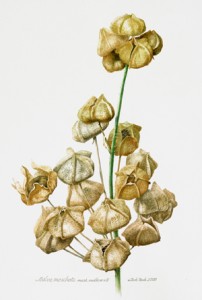 Best-in-Show from the Royal Horticultural Society, the Dianne Bouchier Founder’s Award for Excellence in Botanical Art, president of the American Society of Botanical Artists—with these accolades it would be hard to guess that instructor Dick Rauh had a career in motion picture special effects and graphics before he began to pursue botanical illustration.
Best-in-Show from the Royal Horticultural Society, the Dianne Bouchier Founder’s Award for Excellence in Botanical Art, president of the American Society of Botanical Artists—with these accolades it would be hard to guess that instructor Dick Rauh had a career in motion picture special effects and graphics before he began to pursue botanical illustration.
When his wife enrolled in floral design classes at The New York Botanical Garden, Dick, too, began taking classes at the Garden, a little before retiring. He had always liked to draw trees, and while he was taking gardening classes, NYBG was starting its Botanical Illustration program. Dick began taking the art classes and by 1986 had completed his Certificate in Botanical Art and Illustration.
Dick’s connection with the Garden deepened as he continued to study. Because he was creating illustrations for scientists, he took botany classes to gain a better understanding of the plants and their makeup and also earned a doctorate in biological sciences from CUNY.
Read More
Posted in Emily Dickinson, Holiday Train Show on January 6 2010, by Plant Talk
Celebrating the Season and Looking Ahead to Our Spring Exhibition
 Carol Capobianco is Editorial Content Manager at The New York Botanical Garden.
Carol Capobianco is Editorial Content Manager at The New York Botanical Garden.
Garden staff members have been busy learning all they can about Emily Dickinson and her poetry in advance of the Botanical Garden’s spring exhibition, Emily Dickinson’s Garden: The Poetry of Flowers, May 1–June 13, 2010. We take note wherever and whenever we see her name.
So when we saw in a datebook, by chance, a gingerbread recipe by Emily Dickinson, we decided to blog about it, since the Garden currently is presenting Gingerbread Adventures in the Everett Children’s Adventure Garden as part of the Holiday Train Show.
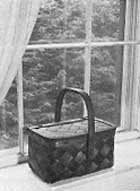 With a little digging around I learned that Dickinson had a bit of a reputation as a baker in her hometown of Amherst, Massachusetts. In fact, she was particularly known for her gingerbread (and Rye and Indian bread), and would lower a basket of it to children below (photo by Lewis S. Mudge, courtesy of his estate), according to Emily Dickinson: Profile of the Poet as Cook, with Selected Recipes, by Nancy Harris Brose, Juliana McGovern Dupre, Wendy Tocher Kohler, and Jean McClure Mudge, and published in 1976. We have a copy of this 28-page booklet in the LuEsther T. Mertz Library, where in spring 60 objects that tell the story of Dickinson’s life will be on view in the Rondina and LoFaro Gallery. (Complementing this will be a re-creation of her garden in the Enid A. Haupt Conservatory and a poetry walk throughout the Garden’s grounds.)
With a little digging around I learned that Dickinson had a bit of a reputation as a baker in her hometown of Amherst, Massachusetts. In fact, she was particularly known for her gingerbread (and Rye and Indian bread), and would lower a basket of it to children below (photo by Lewis S. Mudge, courtesy of his estate), according to Emily Dickinson: Profile of the Poet as Cook, with Selected Recipes, by Nancy Harris Brose, Juliana McGovern Dupre, Wendy Tocher Kohler, and Jean McClure Mudge, and published in 1976. We have a copy of this 28-page booklet in the LuEsther T. Mertz Library, where in spring 60 objects that tell the story of Dickinson’s life will be on view in the Rondina and LoFaro Gallery. (Complementing this will be a re-creation of her garden in the Enid A. Haupt Conservatory and a poetry walk throughout the Garden’s grounds.)
My intention was simply to post the recipe here, with permission from Jean Mudge, and let you try it out for yourself. However, I got caught up in the “everything Emily” mood, and to celebrate her 179th birthday (December 10), I decided to try making the recipe myself to share with co-workers.
Read More
Posted in Exhibitions, Holiday Train Show on January 5 2010, by Plant Talk
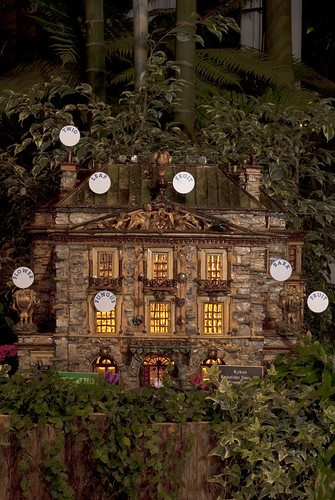 If you’ve read our informative signs at the Holiday Train Show or have absorbed our wonderful show-related blog posts, Web content, or media coverage, you know by now that the New York landmark replicas in the show are made of plant parts and fungi.
If you’ve read our informative signs at the Holiday Train Show or have absorbed our wonderful show-related blog posts, Web content, or media coverage, you know by now that the New York landmark replicas in the show are made of plant parts and fungi.
But do you know what each does when it’s alive, before it becomes an architectural element such as a roof shingle, window, or column on the fantastic buildings and bridges?
Take our quiz and match each plant part and fungus to its botanical role. (You can peek at the signs for hints on your visit to the Holiday Train Show this final week). Let us know how many you got right!
| 1. Bark |
A. moves water and nutrients from roots to leaves |
| 2. Cone |
B. holds and protects the seeds of flowering plants |
| 3. Fruit |
C. holds the seeds of plants that don’t flower |
| 4. Fungus |
D. protects the twigs, branches, and trunk |
| 5. Leaf |
E. consumes other organisms, living or dead |
| 6. Twig |
F. where plants make and store food |
For the answers click
Read More
Posted in Gardening Tips on January 4 2010, by Sonia Uyterhoeven
 |
Sonia Uyterhoeven is Gardener for Public Education. |
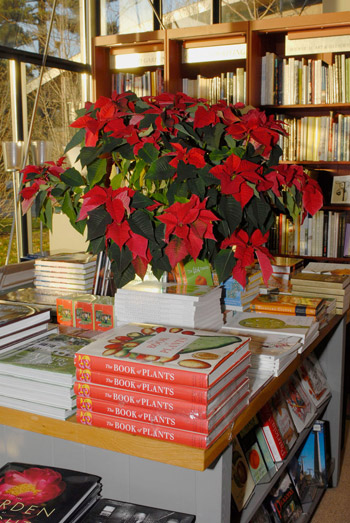 They are ubiquitous during the holiday season…and for good reason. Poinsettias (Euphorbia pulcherrima) are full, colorful plants with an enormous amount of festive appeal. As many of my botanically savvy readers know, the flowers are actually minuscule. The beauty of the poinsettia comes from its large, colorful bracts.
They are ubiquitous during the holiday season…and for good reason. Poinsettias (Euphorbia pulcherrima) are full, colorful plants with an enormous amount of festive appeal. As many of my botanically savvy readers know, the flowers are actually minuscule. The beauty of the poinsettia comes from its large, colorful bracts.
My personal delight with poinsettias is that they come not only in the traditional yuletide red but also in cream and rosy-pink. Whatever your taste, they seem to adorn every church altar and brighten up many homes at this time of year.
I cringe, though, when I see people walking down the street with an open poinsettia in hand, exposed to the elements. Please be an informed shopper and insist that the florist or retailer wraps the plant. This can simply mean temporarily covering the plant with a shopping bag. Remember that this tropical plant cannot handle cool temperatures.
Read More
 John Suskewich is Book Manager for Shop in the Garden.
John Suskewich is Book Manager for Shop in the Garden. A Landscape Manifesto,
A Landscape Manifesto,









